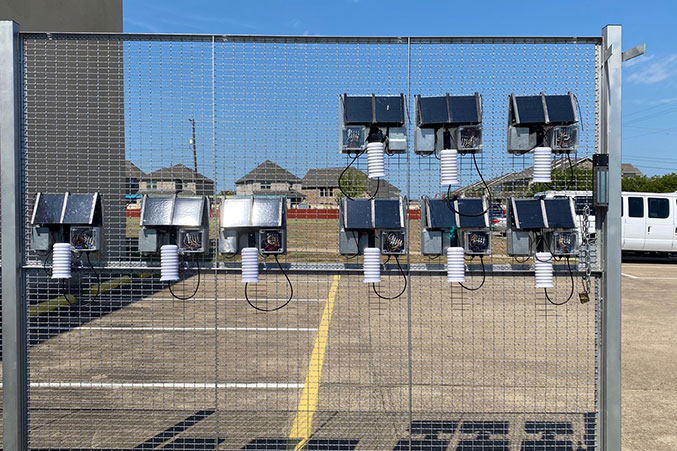Joppa residents breathe more polluted air and report higher cases of asthma and other respiratory issues than local and state averages. Those are the top-line takeaways of a new study by researchers with Texas A&M University, who compared data from neighborhood air monitors with medical diagnoses self-reported by about half of the community’s roughly 500 households.
Eighteen percent of the survey’s respondents reported being diagnosed with asthma at some point in their lives. That’s more than double Dallas-Fort Worth’s 7 percent average asthma rate, and above the 13.5 percent national rate. Researchers also asked a series of physician-approved questions to determine risk of chronic obstructive pulmonary disease, or COPD. About 35 percent were at medium or high risk of developing the condition, the study found.
Meantime, the presence of pollutants in the air exceeded the Environmental Protection Agency’s recommended baseline 24 times in five months, from May to October of 2022, which averaged out to about once each week. The researchers revealed the information to residents at a community event last week.
“This further re-emphasizes the importance of monitoring air quality at the local neighborhood level to inform people about it,” said Dr. Natalie Johnson, a toxicologist at A&M.
The A&M team included experts in both clinical research and public health. Dr. Ping Ma, for instance, previously worked for Children’s Health and now studies social and environmental determinants of health. She said she grew curious at Children’s upon seeing higher illnesses among children in southern Dallas, something that’s since been documented. The work she is helping with in Joppa explores why and how that is.
Their work uses data from three air monitors inside the neighborhood and a survey that sought to identify whether the health conditions associated with pollution exposure are prevalent among the population.
The work was funded by a three-year, $350,000 grant awarded to Texas A&M from the Robert Wood Johnson Foundation. A group of community members helped come up with the survey questions and did the canvassing. The environmental activism nonprofit Downwinders at Risk and other researchers at UTD are responsible for the air monitors; they shared the raw data with the folks from A&M.
The doctors sought to tie what’s known as “particulate matter 2.5” to health outcomes. PM 2.5, as it’s abbreviated, are microscopic pollutants about 100 times smaller than a human hair and can be absorbed into the bloodstream. Exposure, particularly long-term, has been linked to all manner of respiratory ailments and even some neurological issues.
Johnson says PM 2.5 is most often related to sources of combustion, like engines, train locomotives, and the production of concrete—all things that are happening adjacent to homes in Joppa. As the city of Dallas moves forward with a comprehensive land use plan, community members hope the data can inform a zoning change that might provide more of a buffer from nearby industry. Downwinders at Risk is also trying to bring a clinic to the area that would be open a few days a week.
“Ultimately, we do want to de-industrialize that entire area,” said Alicia Kendrick, the leader of the Joppa Environmental Health Project, which was the community representatives in the study. “The next logical step is to bring routine clinical care to Joppa because of the asthma rate.”
Environmental advocates have long tried to quantify the health impacts of living so close to the industrial operators that line the western border of this former freedman’s town. The 2,000 or so people who reside in Joppa are bounded by the Trinity River to the east. The other side bears what Kendrick calls “a peninsula of industry”: the Tamko Building Products shingle factory and a Union Pacific rail yard. The Austin Bridge and Road this year decided to shutter its concrete batch plant, which it had operated since 2009. Councilman Adam Bazaldua helped broker the deal, the Dallas Morning News reported.
Despite its small population, Joppa is not a monolith. It’s common to find different opinions about how to address these matters, which was in full display in KERA’s report from the community meeting held to discuss the study’s findings. The work highlights how the lone EPA monitor is located 9 miles away, in the Medical District, which they believe is too far to get a true read. They maintain that the SharedAir network is the most accurate way to gather real-time data that can inform behavior.
The city has a goal to put 40 air monitors in neighborhoods throughout the city by the end of the year, which would also include a breakdown of the chemicals in the air. It often takes time for the city to move on these matters, which doesn’t always jibe with the speed with which community advocates and activists would prefer to see.
Downwinders at Risk first used monitors here in 2018, as the City Council considered approving a pair of cement batching plants in Joppa. More than 200 people had signed a petition asking the Dallas City Council to block the applications for the plants. Days prior, Downwinders rushed to the neighborhood with mobile monitors that gauged the amount of particulate matter in the air. The group sent its findings to the neighborhood’s councilman ahead of the vote, delivering data to support anecdotes. Council voted 9-5 to not allow the batch plants.
It took another two years install permanent monitors in the neighborhood that would track the prevalence of what’s known as PM 2.5. The three monitors—two on Carbondale Street, near the industrial operators, and another inside the neighborhood at New Zion Missionary Baptist Church—provide immediate reads on air quality, which the public can access from a website.
The city would not comment directly about how it might use the information in the A&M study. It referred instead to a statement from Bazaldua: “Regarding the study’s findings, it would be a great start for the outside organization who conducted these studies to include all necessary neighborhood stakeholders. Neither I, nor the Office of Environmental Quality and Sustainability were informed of the University’s results or invited to last week’s community meeting. There is a problem when any outside organization fails to properly consult the community it aims to serve. I will continue to prioritize improving the quality of life for all residents of Joppa.”
Kendrick says she held “several” calls with the councilman and noted that his environmental commissioner was present during the community meeting. The city would likely say it is working to address the issues of industry in Joppa. It has already seen a concrete batch plant close, and the upcoming land use overhaul has initially recommended rezoning the neighborhood for “light industry” like warehouses instead of what presently operates. It is also installing 40 of its own air monitors around the city, which will be able to detect specific chemicals in the air.
For the researchers and the community, the study brings data to what was previously known anecdotally. They want to see action.
“These people have lived here for years. They know what’s going on,” Kendrick said. “They already know these things, but they might not have the data to back it up.”
What policymakers will do with that data remains to be seen.
Author






